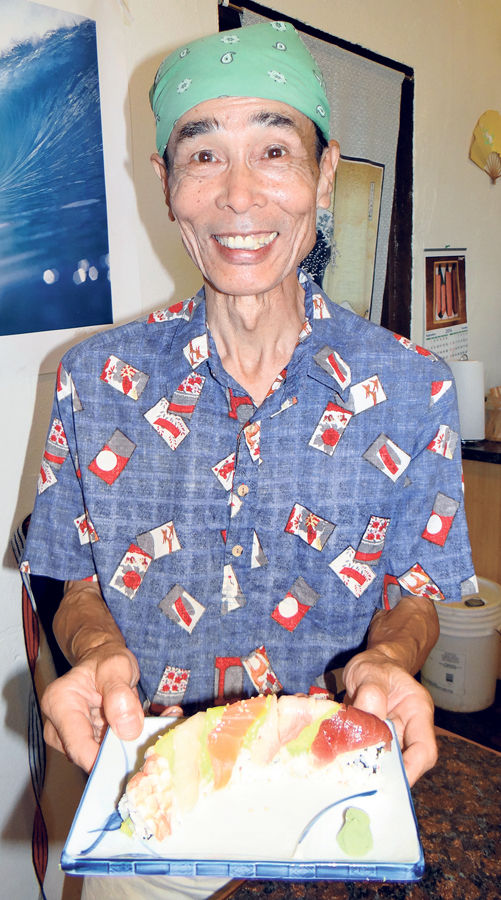LIHUE — From Kauai, via Tokyo, Santa Barbara and the Big Island, Masahiko Chida, owner of Masa’s Sushi Restaurant on Rice Street, said he had always wanted to live in Hawaii. Life on Kauai has been an adventure with a
LIHUE — From Kauai, via Tokyo, Santa Barbara and the Big Island, Masahiko Chida, owner of Masa’s Sushi Restaurant on Rice Street, said he had always wanted to live in Hawaii.
Life on Kauai has been an adventure with a number of interesting chef positions before opening his cozy traditional Japanese restaurant in the heart of Lihue. He celebrated his first year in business last month.
Masahiko spoke to TGI with the help of his friend and translator, Yumi Teraguchi.
The Garden Island: Where have you lived before coming to Kauai?
Masahiko Chida: I am from Tokyo, Japan. My father is from Akita. I left Japan and started out as a teppan grill chef in Santa Barbara, California about 20 years ago. But Hawaii is my dream. From there, I moved to Kona, and then to Hilo on the Big Island. I moved to Kauai about 15 years ago.
TGI: What jobs have you had on Kauai?
MC: I have been a sushi chef for over 20 years. When I came here I ran the “sushi corner” in the Wailua Family Restaurant that is now Brick Oven Pizza. Then I ran the sushi counter at Kiibo Japanese Restaurant in Lihue.
TGI: When did you open Masa Sushi?
MC: I started what is Masa’s Sushi as the sushi corner in Wailua family restaurant. I opened Masa’s sushi at this location in September 2013. This is my one year anniversary.
TGI: Why did you want to come to Hawaii? Was it different than what you expected?
MC: It is humid, and the cost of living is high. But I dreamed of moving to Hawaii because of the warm climate. I don’t like cold. I like it here and do not want to live in Japan.
TGI: What is your vision of a Japanese restaurant on Kauai?
MC: I really care about the tastes of Japan. To taste Japan is to enjoy the ingredients purely. I don’t want too much sauces and other things to cover up the tastes of the ingredients. The taste of the rice is most important.
TGI: You also have other traditional items on the menu other than sushi. What went into creating this modest selection including oyako don and don bori.
MC: I make the sushi and am also the only cook in the kitchen. I selected items that I am comfortable making without other kitchen help.
TGI: With your first year behind you, what are your ideas for the future?
MC: If possible, in the future one of my visions is to serve bento, sukiyaki, and tempura.
TGI: What are the challenges of running a sushi restaurant on Kauai?
MC: It is hard to find good ingredients here and there is less variety than you would find in Japan. Also, when I go to order it, seems the prices are going up every time.
TGI: With sushi roll names like “Sunrise,” “Sunset,” “Sunshine,” and “Orchid,” it seems you have Kauai in mind. What is the creative process of dreaming up a roll that people can relate with an experience?
MC: I pick the name of the roll first and create the roll according to the name. A lot of it is about color, but taste has something to do with the creation too, of course. It’s more like a look, but it has to have a good taste.
TGI: Are there any good stories behind your sushi roll names?
MC: A Masa favorite is the “Tekka.” It is a basic maguro (tuna), rice and nori roll.
In old Japan, when people went to a gambling place called a “tekka ba,” they would snack on this roll while they gambled. That is why they call it the tekka roll today. It is authentic and a very traditional roll that was popular with the samurai.
The “Kappa” roll is cucumber, rice and nori. Its origins are much like the myth of the unicorn or the Menehune. The kappa is green with a flat dish like head that lives in the river. When they fished for kappa in the ancient days, they used cucumber to catch them and that is why they call it the kappa roll.
TGI: Masa’s has the feel of a cozy Japanese noodle restaurant. Is that also in your future plans?
MC: It would be suitable as Japanese food. It would not be practical because of the way the kitchen is set up in back.
TGI: Being from Japan, have you noticed differences with the Mainland and Hawaii?
MC: On the Mainland, they serve the tastes of Japan more than in Hawaii. The first generation tends to carry on the tradition, but at some point, they mixed with Hawaiian tastes and the local flavor.
When I first started serving the tastes of Japan in Hawaii, I recall that some people commented that it tasted weird. It seems that it is more common that Hawaiian Japanese food is sweeter. The younger Hawaiian Japanese customers enjoy my food. We have a great time together.
TGI: Are many of your guests tourists?
MC: Tourists make up about 60 percent of my business, which is why we suffer during these slow times. Business is up and down, up and down. The East and West coast Americans enjoy my sushi because they recognize the authentic tastes of Japan and because it is what they are used to being served at home.


